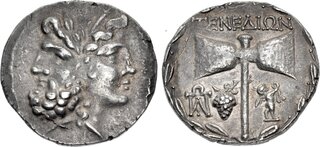| Classical Numismatic Group > Triton XXVII | Auction date: 9 January 2024 |
| Lot number: 238 Price realized: 7,500 USD (Approx. 6,869 EUR) Note: Prices do not include buyer's fees. | Show similar lots on CoinArchives Find similar lots in upcoming auctions on |
| Lot description: ISLANDS off TROAS, Tenedos. Circa 100-70 BC. AR Tetradrachm (30.5mm, 15.73 g, 12h). Stephanophoric type. Janiform head of a bearded male left, laureate, and female right, wearing stephanos / Labrys; TENEΔIΩN above, monogram and grape bunch to left of handle; to right, Eros standing right, holding wreath in both hands; all within wreath. Callataÿ, Tenedos 78 var. (D15/R– [unlisted rev. die]); HGC 6, 390; SNG Berry 988. Toned, struck with worn obverse die, die break at edge on reverse. VF. Well centered. Very rare issue, only five examples recorded by Callataÿ, and four additional in CoinArchives (including this coin). From the JTB Collection. Ex Peus 431 (27 April 2022), lot 3206. With the collapse of Seleukid authority in Asia Minor in 189 BC, many communities of northwestern Asia Minor celebrated their liberation from regal authority by issuing series of large and impressive tetradrachms. All of these coins were struck on the reduced Attic standard, and were struck on broad, thin flans that were influenced by the Athenian New Style coinage. These series also copied a feature on their reverses, a large laurel wreath that formed the border encompassing the entire reverse type. We know from the Delos inventory lists that these coins were referred to as stephanophoroi ("wreath-bearers"), attesting to the ubiquity of these series. The types appearing on the coins clearly indicated their civic nature, depicting the city's patron deity on the obverse and various aspects of the city's culture on the reverse. Regardless of the particular city of issue, the stephanophoric coinage is regarded among the more artistic of the Hellenistic period. This is no surprise as nearly all of the issuing cities were located in western Asia Minor, an area whose numismatic artistry is well attested in the preceding Classical period. While the stephanophoroi represent a benchmark in coin design, the reason for their introduction is not certain, and there is little consensus among numismatists. On one extreme, C. Boehringer argued that their appearance and consistency represented an "Aegean Münzunion" (Boehringer, Chron., pp. 38-9), while at the other O. Mørkholm argued that the wreaths were not indicative of any political or economic significance, but merely the result of a design that gained popularity throughout the northern Aegean ("Chronology and Meaning of the Wreath Coinages of the early 2nd. Cent. B.C.," QT 9 [1980], pp. 145-54). Estimate: 6000 USD |  |



